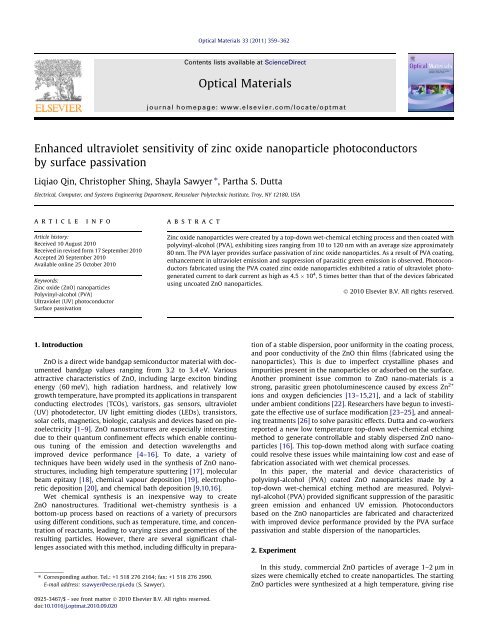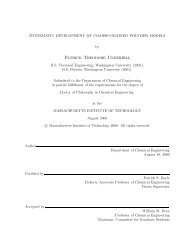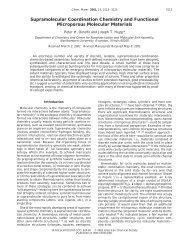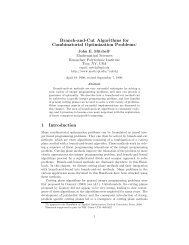Enhanced ultraviolet sensitivity of zinc oxide nanoparticle ...
Enhanced ultraviolet sensitivity of zinc oxide nanoparticle ...
Enhanced ultraviolet sensitivity of zinc oxide nanoparticle ...
Create successful ePaper yourself
Turn your PDF publications into a flip-book with our unique Google optimized e-Paper software.
<strong>Enhanced</strong> <strong>ultraviolet</strong> <strong>sensitivity</strong> <strong>of</strong> <strong>zinc</strong> <strong>oxide</strong> <strong>nanoparticle</strong> photoconductors<br />
by surface passivation<br />
Liqiao Qin, Christopher Shing, Shayla Sawyer ⇑ , Partha S. Dutta<br />
Electrical, Computer, and Systems Engineering Department, Rensselaer Polytechnic Institute, Troy, NY 12180, USA<br />
article info<br />
Article history:<br />
Received 10 August 2010<br />
Received in revised form 17 September 2010<br />
Accepted 20 September 2010<br />
Available online 25 October 2010<br />
Keywords:<br />
Zinc <strong>oxide</strong> (ZnO) <strong>nanoparticle</strong>s<br />
Polyvinyl-alcohol (PVA)<br />
Ultraviolet (UV) photoconductor<br />
Surface passivation<br />
1. Introduction<br />
abstract<br />
ZnO is a direct wide bandgap semiconductor material with documented<br />
bandgap values ranging from 3.2 to 3.4 eV. Various<br />
attractive characteristics <strong>of</strong> ZnO, including large exciton binding<br />
energy (60 meV), high radiation hardness, and relatively low<br />
growth temperature, have prompted its applications in transparent<br />
conducting electrodes (TCOs), varistors, gas sensors, <strong>ultraviolet</strong><br />
(UV) photodetector, UV light emitting diodes (LEDs), transistors,<br />
solar cells, magnetics, biologic, catalysis and devices based on piezoelectricity<br />
[1–9]. ZnO nanostructures are especially interesting<br />
due to their quantum confinement effects which enable continuous<br />
tuning <strong>of</strong> the emission and detection wavelengths and<br />
improved device performance [4–16]. To date, a variety <strong>of</strong><br />
techniques have been widely used in the synthesis <strong>of</strong> ZnO nanostructures,<br />
including high temperature sputtering [17], molecular<br />
beam epitaxy [18], chemical vapour deposition [19], electrophoretic<br />
deposition [20], and chemical bath deposition [9,10,16].<br />
Wet chemical synthesis is an inexpensive way to create<br />
ZnO nanostructures. Traditional wet-chemistry synthesis is a<br />
bottom-up process based on reactions <strong>of</strong> a variety <strong>of</strong> precursors<br />
using different conditions, such as temperature, time, and concentration<br />
<strong>of</strong> reactants, leading to varying sizes and geometries <strong>of</strong> the<br />
resulting particles. However, there are several significant challenges<br />
associated with this method, including difficulty in prepara-<br />
⇑ Corresponding author. Tel.: +1 518 276 2164; fax: +1 518 276 2990.<br />
E-mail address: ssawyer@ecse.rpi.edu (S. Sawyer).<br />
0925-3467/$ - see front matter Ó 2010 Elsevier B.V. All rights reserved.<br />
doi:10.1016/j.optmat.2010.09.020<br />
Optical Materials 33 (2011) 359–362<br />
Contents lists available at ScienceDirect<br />
Optical Materials<br />
journal homepage: www.elsevier.com/locate/optmat<br />
Zinc <strong>oxide</strong> <strong>nanoparticle</strong>s were created by a top-down wet-chemical etching process and then coated with<br />
polyvinyl-alcohol (PVA), exhibiting sizes ranging from 10 to 120 nm with an average size approximately<br />
80 nm. The PVA layer provides surface passivation <strong>of</strong> <strong>zinc</strong> <strong>oxide</strong> <strong>nanoparticle</strong>s. As a result <strong>of</strong> PVA coating,<br />
enhancement in <strong>ultraviolet</strong> emission and suppression <strong>of</strong> parasitic green emission is observed. Photoconductors<br />
fabricated using the PVA coated <strong>zinc</strong> <strong>oxide</strong> <strong>nanoparticle</strong>s exhibited a ratio <strong>of</strong> <strong>ultraviolet</strong> photogenerated<br />
current to dark current as high as 4.5 10 4 , 5 times better than that <strong>of</strong> the devices fabricated<br />
using uncoated ZnO <strong>nanoparticle</strong>s.<br />
Ó 2010 Elsevier B.V. All rights reserved.<br />
tion <strong>of</strong> a stable dispersion, poor uniformity in the coating process,<br />
and poor conductivity <strong>of</strong> the ZnO thin films (fabricated using the<br />
<strong>nanoparticle</strong>s). This is due to imperfect crystalline phases and<br />
impurities present in the <strong>nanoparticle</strong>s or adsorbed on the surface.<br />
Another prominent issue common to ZnO nano-materials is a<br />
strong, parasitic green photoluminescence caused by excess Zn 2+<br />
ions and oxygen deficiencies [13–15,21], and a lack <strong>of</strong> stability<br />
under ambient conditions [22]. Researchers have begun to investigate<br />
the effective use <strong>of</strong> surface modification [23–25], and annealing<br />
treatments [26] to solve parasitic effects. Dutta and co-workers<br />
reported a new low temperature top-down wet-chemical etching<br />
method to generate controllable and stably dispersed ZnO <strong>nanoparticle</strong>s<br />
[16]. This top-down method along with surface coating<br />
could resolve these issues while maintaining low cost and ease <strong>of</strong><br />
fabrication associated with wet chemical processes.<br />
In this paper, the material and device characteristics <strong>of</strong><br />
polyvinyl-alcohol (PVA) coated ZnO <strong>nanoparticle</strong>s made by a<br />
top-down wet-chemical etching method are measured. Polyvinyl-alcohol<br />
(PVA) provided significant suppression <strong>of</strong> the parasitic<br />
green emission and enhanced UV emission. Photoconductors<br />
based on the ZnO <strong>nanoparticle</strong>s are fabricated and characterized<br />
with improved device performance provided by the PVA surface<br />
passivation and stable dispersion <strong>of</strong> the <strong>nanoparticle</strong>s.<br />
2. Experiment<br />
In this study, commercial ZnO particles <strong>of</strong> average 1–2 lm in<br />
sizes were chemically etched to create <strong>nanoparticle</strong>s. The starting<br />
ZnO particles were synthesized at a high temperature, giving rise
360 L. Qin et al. / Optical Materials 33 (2011) 359–362<br />
to pure crystalline phases and high purity <strong>of</strong> the synthesized<br />
powders. Using the slow and controllable top-down chemical etching<br />
process described here, <strong>nanoparticle</strong>s as small as 10 nm sizes<br />
have been demonstrated. To start with, the micron size ZnO particles<br />
were suspended in deionized water using a magnetic stirrer.<br />
The solid weight percent <strong>of</strong> the ZnO particles in water was approximately<br />
2.5%. A separate mild acidic solution (pH 6) was prepared<br />
by adding acetic acid in water. The acidic solution was then added<br />
drop by drop (at a rate <strong>of</strong> 2–3 ml every minute) to the ZnO colloidal<br />
suspension while the liquid was vigorous stirred. The acetic acid<br />
etches ZnO by forming <strong>zinc</strong> acetate which dissolved in water. After<br />
2 h <strong>of</strong> etching, the solution was centrifuged and the ZnO particles<br />
were extracted. The extracted particles were suspended in deionized<br />
water and washed. The solution was then centrifuged and<br />
the particles were extracted again. The etching process is repeated<br />
several times as described above beginning with suspending the<br />
extracted ZnO particles in water and adding acetic acid solution<br />
for 2 h. After six etching cycles it was observed that ZnO <strong>nanoparticle</strong>s<br />
with size below 100 nm could be obtained. At the end <strong>of</strong> this<br />
etching process, the colloidal suspension was separated into two<br />
batches. One batch was surface treated by dissolving PVA<br />
(0.5% in weight in water). The PVA capping on the ZnO <strong>nanoparticle</strong>s<br />
occurred due to the reaction <strong>of</strong> excess Zn 2+ on the surface with<br />
the hydroxyl group <strong>of</strong> the PVA. The particles from both batches<br />
[uncoated (ZnO–A) and PVA-coated (ZnO–U)] were centrifuged<br />
and dispersed in ethanol to form 30 mg/ml suspension. These solutions<br />
were then spin-casted onto quartz plates and annealed in air<br />
at 150 °C for 5 min.<br />
Characterization methods used to determine the material quality<br />
and optical characteristics <strong>of</strong> the ZnO <strong>nanoparticle</strong>s are the following.<br />
X-ray diffraction (XRD) was performed on a Bruker D8<br />
Discover X-ray diffractometer with a high-star 2-d detector. The<br />
2-theta used in the measurement was from 30° to 100°. The size<br />
and morphology <strong>of</strong> the ZnO <strong>nanoparticle</strong>s were determined using<br />
a Carl Zeiss Ultra 1540 dual beam scanning electron microscope<br />
(SEM) set to 5 kV. The ZnO <strong>nanoparticle</strong>s were characterized by<br />
their excitation and emission spectra using a Spex Fluorolog<br />
Tau-3 spectr<strong>of</strong>luorimeter. UV–Vis absorption spectra were recorded<br />
using a Shimadzu UV–Vis 2550 spectrophotometer with a<br />
deuterium lamp (190–390 nm) and a halogen lamp (280–<br />
1100 nm). Auto switching between the lamps is synchronized to<br />
a wavelength and the switching range is selectable between 282<br />
and 393 nm. The scanning wavelength range used in the experiment<br />
is 240–800 nm with a switching wavelength <strong>of</strong> 330 nm.<br />
Photoconductors were made by depositing two irregular<br />
100 nm Al contacts on top <strong>of</strong> the ZnO <strong>nanoparticle</strong> film formed<br />
as stated above using E-beam via shadow mask. A schematic diagram<br />
<strong>of</strong> the detectors is presented in the inset <strong>of</strong> Fig. 1(b). Point<br />
contact current–voltage (I-V) characteristics <strong>of</strong> samples were measured<br />
using a HP4155B semiconductor parameter analyzer under<br />
darkness and under illumination by a 340 nm UV LED with an<br />
intensity <strong>of</strong> 45.58 mW/cm 2 . These measurements were performed<br />
at room temperature in air.<br />
3. Results and discussion<br />
The XRD pattern <strong>of</strong> ZnO <strong>nanoparticle</strong>s coated with PVA (ZnO–U)<br />
is shown in Fig. 1(a). The peaks coincide with hexagonal <strong>zinc</strong> <strong>oxide</strong><br />
(AMCSD#0005163, a = 3.2494 Å, c = 5.2038 Å) <strong>of</strong> high purity.<br />
Fig. 1(b) is a high resolution SEM image <strong>of</strong> PVA coated ZnO <strong>nanoparticle</strong>s<br />
(ZnO–U) spin-casted onto a quartz plate. The sizes <strong>of</strong><br />
the <strong>nanoparticle</strong>s are in the range <strong>of</strong> 10–150 nm with an average<br />
value <strong>of</strong> approximately 80 nm. Uncoated ZnO <strong>nanoparticle</strong>s<br />
(ZnO–A) in ethanol spin-casted on quartz plates exhibit a similar<br />
size.<br />
Fig. 1. (a) XRD patterns (b) High resolution SEM results, <strong>of</strong> PVA coated ZnO<br />
<strong>nanoparticle</strong>s (ZnO–U) created by top-down wet-chemical synthesis with an<br />
average size <strong>of</strong> 80 nm (the inset is the schematic diagram <strong>of</strong> the photoconductors).<br />
Fig. 2. Emission spectra <strong>of</strong> ZnO excited at 340 nm indicating enhanced UV and<br />
suppressed green emission in PVA coated ZnO <strong>nanoparticle</strong>s (ZnO–U) in contrast to<br />
uncoated ZnO <strong>nanoparticle</strong>s (ZnO–A) (the inset is the normalized spectra).<br />
The emission spectra <strong>of</strong> the uncoated ZnO <strong>nanoparticle</strong>s<br />
(ZnO–A), shown in Fig. 2, demonstrate two transitions exist: a<br />
near-band-edge UV transition and a broad green emission caused
Fig. 3. Excitation spectra <strong>of</strong> ZnO (kem = 510 nm) (the inset schematically shows the<br />
near-band-edge and the green emission <strong>of</strong> ZnO, respectively).<br />
by deep level defects. This corresponds with the transitions shown<br />
in the Fig. 3 inset <strong>of</strong> the ZnO band diagram. When excited at<br />
340 nm, the emission spectra clearly indicate an enhanced UV<br />
and a diminished parasitic green emission occurs in PVA coated<br />
ZnO <strong>nanoparticle</strong>s (ZnO–U) compared with uncoated ZnO <strong>nanoparticle</strong>s<br />
(ZnO–A). The ratio <strong>of</strong> UV emission peak (377 nm) to the<br />
green emission peak (520 nm) increased from 0.93 in uncoated<br />
ZnO <strong>nanoparticle</strong>s (ZnO–A) to 40.85 in PVA coated ZnO <strong>nanoparticle</strong>s<br />
(ZnO–U).<br />
The excitation spectra <strong>of</strong> the ZnO <strong>nanoparticle</strong>s are shown in<br />
Fig. 3. When the emission wavelength was set at 510 nm (around<br />
the peak <strong>of</strong> the parasitic green emission <strong>of</strong> ZnO) the excitation<br />
spectra indicated most <strong>of</strong> the parasitic green emission comes from<br />
UV excitation. The UV-excited electrons in the conduction band<br />
cannot recombine with the holes in the valence band since they<br />
are trapped by the holes in the deep level defects <strong>of</strong> ZnO. However,<br />
the green emission from uncoated ZnO <strong>nanoparticle</strong>s (ZnO–A) is<br />
about 4 times <strong>of</strong> that from PVA coated ZnO <strong>nanoparticle</strong>s<br />
(ZnO–U). This indicates the PVA coating helps passivate the surface<br />
<strong>of</strong> ZnO <strong>nanoparticle</strong>s by decreasing the number <strong>of</strong> holes in the deep<br />
level and thus reducing the parasitic green photoluminescence <strong>of</strong><br />
Fig. 4. Absorption spectra <strong>of</strong> ZnO demonstrate higher UV and lower visible<br />
absorption in PVA coated ZnO <strong>nanoparticle</strong>s (ZnO–U) comparing with uncoated<br />
ZnO <strong>nanoparticle</strong>s (ZnO–A).<br />
L. Qin et al. / Optical Materials 33 (2011) 359–362 361<br />
Fig. 5. I–V plot <strong>of</strong> photodetector based on PVA coated ZnO <strong>nanoparticle</strong>s (ZnO–U)<br />
shows a linear I–V response and the UV generated current to dark current ratio over<br />
four orders.<br />
Fig. 6. The ratio <strong>of</strong> UV generated current to dark current <strong>of</strong> photodetector based on<br />
uncoated ZnO <strong>nanoparticle</strong>s (ZnO–A) and PVA coated ZnO <strong>nanoparticle</strong>s (ZnO–U)<br />
respectively.<br />
ZnO following UV-excitation. Excess Zn 2+ is normally considered<br />
the major contributor to green emission since the dangling bonds<br />
form the donor states in ZnO that easily trap the UV-excited electrons<br />
[13–15,21,27,28]. Therefore the suppressed green emission<br />
observed in PVA coated ZnO <strong>nanoparticle</strong>s (ZnO-U) indicates PVA<br />
is an effective surface passivation material to ZnO and has a strong<br />
interaction with excess Zn 2+ .<br />
As demonstrated in Fig. 4, there is no significant difference in<br />
the absorption spectra <strong>of</strong> uncoated ZnO <strong>nanoparticle</strong>s (ZnO–A)<br />
and PVA coated ZnO <strong>nanoparticle</strong>s (ZnO–U), although PVA coated<br />
ZnO <strong>nanoparticle</strong>s (ZnO–U) exhibits an increase in UV absorption<br />
and a slight decrease in visible wavelength absorption. The absorption<br />
spectra shows the cut-<strong>of</strong>f wavelengths for both samples to be<br />
around 375 nm, a 5 nm blue shift compared with the bulk material<br />
(380 nm). This indicates the presence <strong>of</strong> nano-scale particles (as<br />
shown in the high resolution SEM results <strong>of</strong> Fig. 1(b)) and their corresponding<br />
quantum confinement effect in these samples.<br />
Fig. 5 is a typical I–V curve <strong>of</strong> photoconductors based on ZnO<br />
<strong>nanoparticle</strong>s under dark and illuminations <strong>of</strong> 340 nm UV LED with<br />
an intensity <strong>of</strong> 45.58 mW/cm 2 . The linear I–V responses show that<br />
a photoconductor based on ZnO <strong>nanoparticle</strong>s and Al contacts has
362 L. Qin et al. / Optical Materials 33 (2011) 359–362<br />
been achieved. The ratios <strong>of</strong> UV photo-generated current to dark<br />
current (on/<strong>of</strong>f ratio) are shown in Fig. 6. In uncoated ZnO <strong>nanoparticle</strong>s<br />
(ZnO–A), the ratio is about 9 10 3 when the bias is 20 V.<br />
Meanwhile, for PVA coated ZnO <strong>nanoparticle</strong>s (ZnO–U) the ratio<br />
is as high as 4.5 10 4 , 5 times that <strong>of</strong> uncoated ZnO <strong>nanoparticle</strong>s<br />
(ZnO–A). Since most <strong>of</strong> the UV-generated carriers in the ZnO are<br />
trapped by defects during transportation to the terminals and uncoated<br />
ZnO <strong>nanoparticle</strong>s (ZnO–A) has a higher surface defect concentration<br />
than PVA coated ZnO <strong>nanoparticle</strong>s (ZnO–U), this<br />
increased ratio is expected. However, the dark currents <strong>of</strong> both<br />
detectors are about 100pA at 20 V bias. This indicates PVA does<br />
not change the conductivity <strong>of</strong> ZnO <strong>nanoparticle</strong>s, but acts as an<br />
effective surface passivation material to improve the photo<strong>sensitivity</strong><br />
<strong>of</strong> ZnO <strong>nanoparticle</strong>s. The charge transport mechanism<br />
across the ZnO/PVA/Al is still under investigation. However, it is<br />
speculated that it could be due to tunnelling.<br />
4. Conclusion<br />
In conclusion, enhanced UV emission and suppression <strong>of</strong> parasitic<br />
green photoluminescence has been observed in PVA coated<br />
ZnO <strong>nanoparticle</strong>s prepared using a top-down wet-chemical etching<br />
process. Photoconductor based on PVA coated ZnO exhibited<br />
increase in photocurrent <strong>sensitivity</strong>. These results indicate that<br />
PVA coating <strong>of</strong> ZnO <strong>nanoparticle</strong>s could be applied in creating<br />
low cost, sensitive and visible blind UV photodetectors.<br />
Acknowledgements<br />
The authors gratefully acknowledge support from National<br />
Security Technologies through NSF Industry/University Cooperative<br />
Research Center Connection One. The authors also acknowl-<br />
edge the National Science Foundation Smart Lighting Engineering<br />
Research Center (EEC-0812056).<br />
References<br />
[1] J. Sheu, M. Lee, C. Tun, S. Lin, Appl. Phys. Lett. 88 (2006) 043506.<br />
[2] P. Durán, F. Capel, J. Tartaj, C. Moure, Adv. Mater. 14 (2002) 137.<br />
[3] D. Lin, H. Wu, W. Zhang, He. Li, W. Pan, Appl. Phys. Lett. 94 (2009) 172103.<br />
[4] E. Neshataeva, T. Kümmell, G. Bacher, A. Ebbers, Appl. Phys. Lett. 94 (2009)<br />
091115.<br />
[5] S. Lee, Y. Jeong, S. Jeong, J. Lee, M. Jeon, J. Moon, Superlatt. Microstruc. 44<br />
(2008) 761.<br />
[6] M. Wang, Y. Lian, X. Wang, Curr. Appl. Phys. 9 (2009) 189.<br />
[7] X. Zhua, I. Yurib, X. Gana, I. Suzukib, G. Lia, Biosens. Bioelectron. 22 (2007)<br />
1600.<br />
[8] Y. Qin, X. Wang, Z. Wang, Nature 451 (2008) 809.<br />
[9] Y. Jin, J. Wang, B. Sun, J. Blakesley, N. Greenham, Nano Lett. 8 (2008) 1649.<br />
[10] Y. Lin, C. Chen, W. Yen, W. Su, C. Ku, J. Wu, Appl. Phys. Lett. 92 (2008) 233301.<br />
[11] G. Cheng, Z. Li, S. Wang, G. Gong, K. Cheng, X. Jiang, S. Zhou, Z. Du, T. Cui, G.<br />
Zou, Appl. Phys. Lett. 93 (2008) 123103.<br />
[12] J. Jun, H. Seong, K. Cho, B. Moon, S. Kim, Ceram. Int. 35 (2009) 2797.<br />
[13] S. Monticone, R. Tufeu, A. Kanaev, J. Phys. Chem. B 102 (1998) 2854.<br />
[14] Y. Wu, A. Tok, F. Boey, X. Zeng, X. Zhang, Appl. Surf. Sci. 253 (2007) 5473.<br />
[15] L. Wu, Y. Wu, X. Pan, F. Kong, Opt. Mater. 28 (2006) 418.<br />
[16] S. Sharma, A. Tran, O. Nalamasu, P. Dutta, J. Electron. Mater. 35 (2006) 1237.<br />
[17] Z. Bi, J. Zhang, X. Bian, D. Wang, X. Zhang, W. Zhang, Z. Hou, J. Electron. Mater.<br />
37 (2008) 760.<br />
[18] W. Heo, V. Varadarajan, M. Kaufman, K. Kim, D. Norton, F. Ren, P. Fleming,<br />
Appl. Phys. Lett. 81 (2002) 3046.<br />
[19] A. Umar, S. Lee, Y. Lee, K. Nahm, Y. Hahn, J. Cryst. Growth 277 (2005) 479.<br />
[20] Y. Wang, I. Leu, M. Hon, Electrochem. Solid-State Lett. 5 (2002) 53.<br />
[21] K. Borgohain, S. Mahamuni, Semicond. Sci. Technol. 13 (1998) 1154.<br />
[22] D. Talapin, A. Rogach, E. Shevchenko, A. Kornowski, M. Hasse, M. Hasse, H.<br />
Weller, J. Am. Chem. Soc. 124 (2002) 5782.<br />
[23] H. Xiong, Z. Wang, Y. Xia, Adv. Mater. 18 (2006) 748.<br />
[24] L. Guo, S. Yang, C. Yang, P. Yu, J. Wang, W. Ge, G. Wong, Appl. Phys. Lett. 76<br />
(2000) 2901.<br />
[25] S. Mridha, M. Nandi, A. Bhaumik, D. Basak, Nanotechnology 19 (2008) 275705.<br />
[26] S. Venkataprasad Bhat, S.R.C. Vivekchand, A. Govindaraj, C.N.R. Rao, Solid State<br />
Commun. 149 (2009) 510.<br />
[27] V.A. Fonoberov, A.A. Balandin, Appl. Phys. Lett. 85 (2004) 5971 (2004).<br />
[28] V.A. Fonoberov, K.A. Alim, A.A. Balandin, Phys. Rev. B 73 (2006) 165317.







